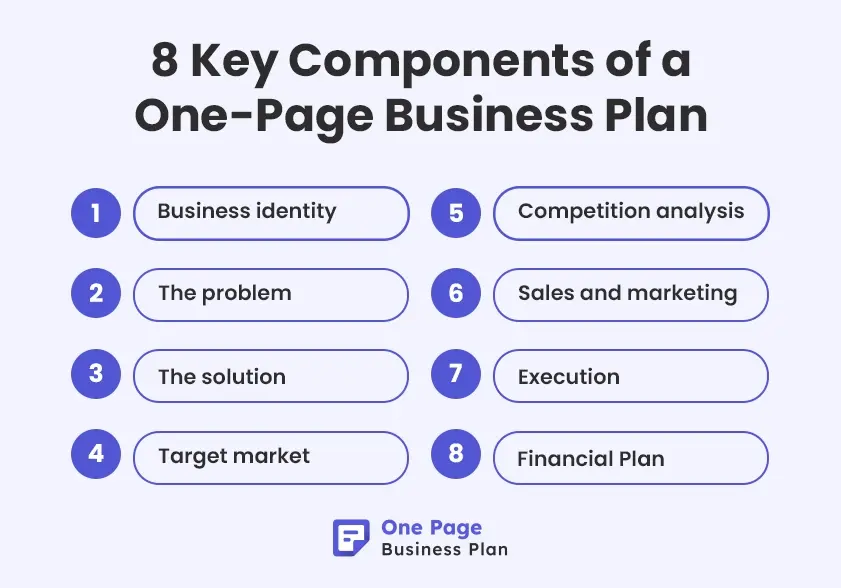What if we told you, you don’t need a 50-page manifesto, you call a business plan?
Yes, it’s true!
There are times when all you need is a one-page business plan that is crisp, concise, yet informative to impress investors and other readers—something you need in a world where attention spans rival that of a goldfish.
That’s why, it’s crucial you know the key components you can’t afford to miss in your one-page plan. What are they, you ask?
Don’t worry, we’ve created a list of 8 key components of a one-page business plan, so you don’t have to scavenge the internet any further. Let’s dive in.
8 key components of a one-page business plan
Here are the key components you have to have in your one-page plan to make sure you don’t miss out on details while keeping it concise:

1. Business identity
This first key component lies at the heart of your business plan—the essence of who you are and what you bring to the table. In short, it answers: What does your business do?
So start by sharing your core offering such as a product or service and why anyone should care. While sharing, remember your explanation must be straightforward, engaging, and jargon-free.
Next, highlight your value proposition. Explain what sets you apart from the competition. Are you cheaper? Are you faster? Are you the one in a brand new innovative field? Your value proposition is what you promise to bring to the table for your customers, and how your business fulfills their requirements.
Lastly, business identity being the first component, you want to impress the reader in the first few seconds and keep them wanting more. Make sure the first 30 seconds make your core offering and value proposition stand out!
2. The problem
Next, you want to mention the problems of the target customers that your product or service will solve. Convince your readers of the problem that really needs a solution—making it relatable.
3. The solution
With the problem out in the air, explain your solution, that is, how your product or services will fix the mentioned problem. Place the solution in the best light and how it can be the only solution fit for your audience.
4. Target market
Your target market AKA people most likely to purchase your products or services. And unless such people exist, you might as well stop creating your business plan.
So start by analyzing the market you’re trying to penetrate and find out who your customers are and why they need your product.
It’s important to let your investors know you’ve done your research regarding who will buy your product or services so they know you mean business and have a basis to last long term.
5. Competition analysis
This key component is essential to thrive in a cutthroat world of competition. Analyze your competitive landscape to discover who your top competitors are, along with their strengths and weaknesses. As a result, you’ll understand how viable your business is as compared to other leaders and competitors in the industry.
Now this can seem information heavy, but for a one-page business plan, you want to highlight only the key aspects like:
- Companies leading in the keyword searches you’d like to rank.
- The unique pricing model that will disrupt the market.
6. Sales and marketing
With your target market and competitors in sight, the next key component is (with zero surprises) sales and marketing. Because that’s how you make money and spread the word regarding your company to keep your business afloat.
Here, explain the game plan behind how you plan to draw customers and ensure sales. For example, will you use social media? Or paid ads? Or email marketing? Or good old coupons? Dish it all out.
It’s only going to show potential investors you have a plan as to how to make money so they can trust in their investment.
7. Execution
This component gives a quick snapshot of two broad aspects.
One: Milestones. And two: Team.
Your milestones will explain the short-term and long-term goals you need to achieve. The description of your team and partners, their skills, and expertise will show that you can achieve those goals.
In short, investors would love to know you have the right goals and resources to execute operations and lead your business to success.
8. Financial Plan
Lastly, talk money. A strong financial plan includes an analysis that provides a snapshot of your business’s current and future financial health. It should include:
- Estimates of the costs, revenue, and profits of your business.
- How you plan to finance your business.
- Costs you’ll incur before opening day.
- Ongoing costs.
Not only will this give your vendors and investors confidence in your business, but it helps you ensure your business is here to stay and make bank.
Now before you end up inserting all the details proving your profitability, remember it’s a one-page business plan. So it’s best to focus on ratios and numbers that explain financial projections in a few words. For example:
- Revenue projections
- Key expenses
- Net profit Margin
- Total debt to total assets
- Break-even analysis
- Accounts payable turnover
- Funding requirements (if applicable)
That’s about it. These key components will build you a solid one-page plan. Speaking of building one…
Start drafting a plan with the one-page business plan
Now that you know all the key components you can begin crafting your one-page business plan. But if you want to skip manually starting from scratch, try the one-page business plan to get started.
Simply enter details about your business model, fill in a few blanks, and let its AI generator create an investor-ready one-page business plan for you—all for no cost.
Try today!
Frequently Asked Questions
Why is a mission statement important in a one-page business plan?
A mission statement is important in a one-page business plan because it allows employees, investors, distributors, suppliers, and other major stakeholders to stay on the same page. It's an excellent way to ensure they all keep their values and goals aligned with those of your company.
What goals should I include in my one-page business plan?
In your one-page business plan, include goals that cover key areas like revenue growth, customer acquisition, and product development. For example:
- Launch a new product feature by Q3.
- Achieve 20% revenue growth within the next year.
- Secure 100 new customers in the first six months.
How detailed should financial projections be in a one-page business plan?
In a one-page business plan, financial projections should be concise yet informative. You can do so by focusing on key figures like expected revenue, profit margins, and cash flow. Don’t forget to highlight major costs and break down projections into quarterly or annual milestones. The idea is to give a quick brief on your business’s financial health without overloading the document with overwhelming details—just enough to show viability and growth potential.
Can I customize the elements of my one-page business plan?
Yes, you can customize the elements of your one-page business plan to suit your business needs! A one-page plan is flexible, so you can even make some sections longer if that’s what’s beneficial for your business.

